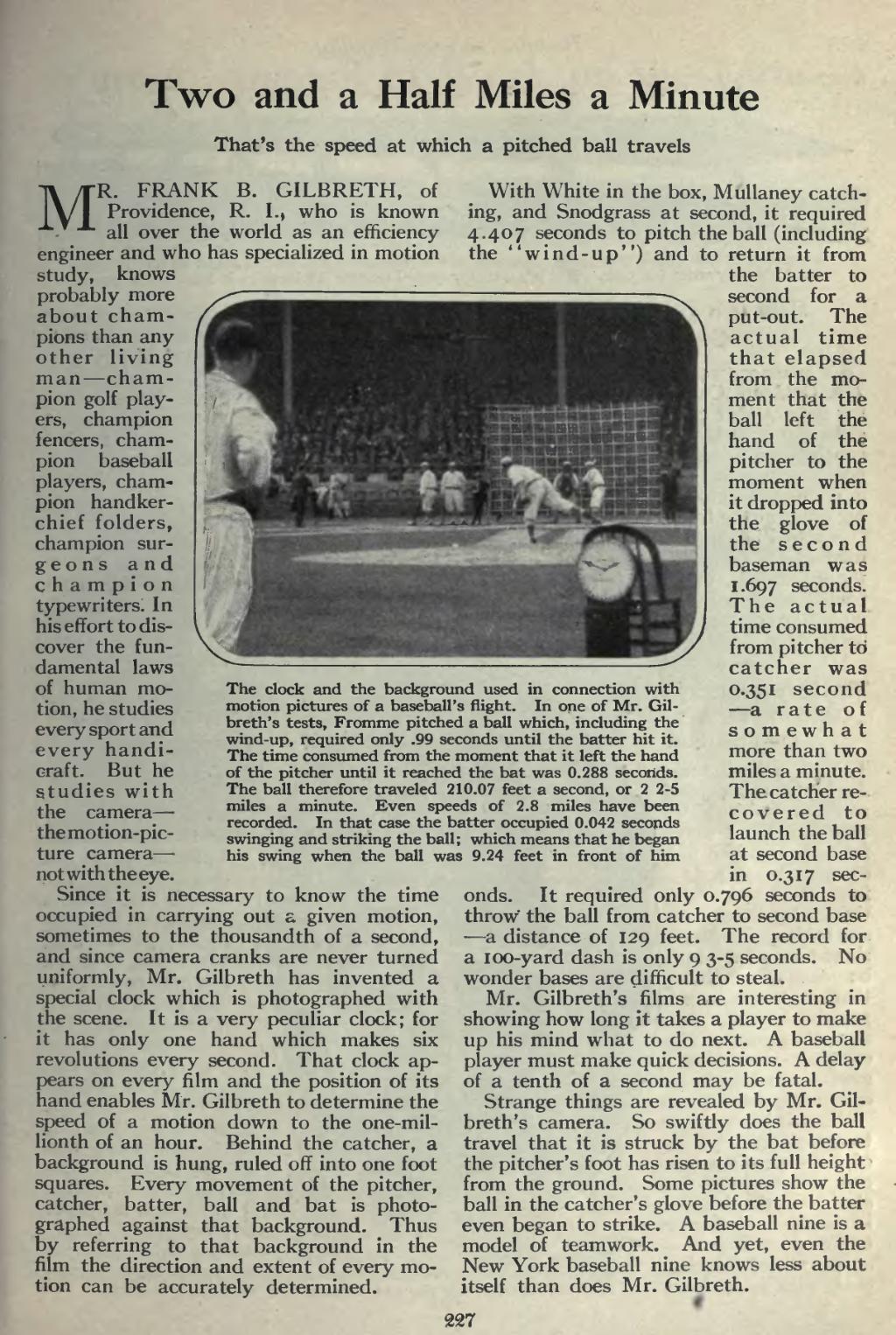Two and a Half Miles a Minute
That's the speed at which a pitched ball travels
���MR. FRANK B. GILBRETH, of Providence, R. I., who is known all over the world as an efficiency- engineer and who has specialized in motion study, knows probably more about cham- pions than any other living man — cham- pion golf play- ers, champion fencers, cham- pion baseball players, cham- pion handker- chief folders, champion sur- geons and champion typewriters. In his effort to dis- cover the fun- damental laws of human mo- tion, he studies every sport and every handi- craft. But he studies with the camera — the motion-pic- ture camera — not with the eye.
Since it is necessary to know the time occupied in carrying out a given motion, sometimes to the thousandth of a second, and since camera cranks are never turned uniformly, Mr. Gilbreth has invented a special clock which is photographed with the scene. It is a very peculiar clock; for it has only one hand which makes six revolutions every second. That clock ap- pears on every film and the position of its hand enables Mr. Gilbreth to determine the speed of a motion down to the one-mil- lionth of an hour. Behind the catcher, a background is hung, ruled off into one foot squares. Every movement of the pitcher, catcher, batter, ball and bat is photo- graphed against that background. Thus by referring to that background in the film the direction and extent of every mo- tion can be accurately determined.
��The clock and the background used in connection with motion pictures of a baseball's flight. In one of Mr. Gil- breth's tests, Fromme pitched a ball which, including the wind-up, required only .99 seconds until the batter hit it. The time consumed from the moment that it left the hand of the pitcher until it reached the bat was 0.288 seconds. The ball therefore traveled 210.07 feet a second, or 2 2-5 miles a minute. Even speeds of 2.8 miles have been recorded. In that case the batter occupied 0.042 seconds swinging and striking the ball ; which means that he began his swing when the ball was 9.24 feet in front of him
��With White in the box, Mullaney catch- ing, and Snodgrass at second, it required 4.407 seconds to pitch the ball (including the "wind-up") and to return it from the batter to second for a put-out. The actual time that elapsed from the mo- ment that the ball left the hand of the pitcher to the moment when it dropped into the glove of the second baseman was 1.697 seconds. The actual time consumed from pitcher to catcher was 0.351 second — a rate of somewhat more than two miles a minute. The catcher re- covered to launch the ball at second base in 0.317 sec- onds. It required only 0.796 seconds to throw the ball from catcher to second base ■ — a distance of 129 feet. The record for a 100-yard dash is only 9 3-5 seconds. No wonder bases are difficult to steal.
Mr. Gilbreth's films are interesting in showing how long it takes a player to make up his mind what to do next. A baseball player must make quick decisions. A delay of a tenth of a second may be fatal.
Strange things are revealed by Mr. Gil- breth's camera. So swiftly does the ball travel that it is struck by the bat before the pitcher's foot has risen to its full height from the ground. Some pictures show the ball in the catcher's glove before the batter even began to strike. A baseball nine is a model of teamwork. And yet, even the New York baseball nine knows less about itself than does Mr. Gilbreth.
��227
�� �
